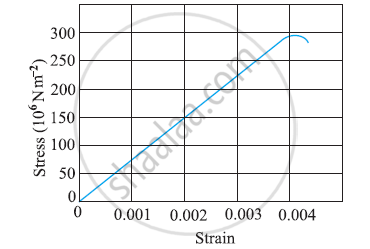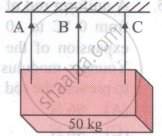Advertisements
Advertisements
प्रश्न
The length of a metal wire is l1 when the tension in it T1 and is l2 when the tension is T2. The natural length of the wire is
विकल्प
\[\frac{\text{ l}_1 + \text{l}_2}{2}\]
\[\sqrt{\text{ l}_1 \text{l}_2}\]
\[\frac{\text{l}_1 \text{T}_2 - \text{l}_2 \text{T}_1}{\text{T}_2 - \text{T}_1}\]
\[\frac{\text{l}_1 \text{T}_2 + \text{l}_2 \text{T}_1}{\text{T}_2 + \text{T}_1}\]
उत्तर
\[\text{ Let the Young's modulus be Y }. \]
\[\text{C . S . A . = A}\]
\[\text{Actual length of the wire = L}\]
\[\text{For tension T}_1 : \]
\[Y = \frac{\frac{T_1}{A}}{\frac{\left( \text{L - l}_1 \right)}{L}} . . . (1)\]
\[\text{ For tension T}_2 : \]
\[Y = \frac{\frac{T_2}{A}}{\frac{\left( \text{L - l}_2 \right)}{L}} . . . (2)\]
\[\text{ From (1) and (2): }\]
\[\frac{\frac{T_1}{A}}{\frac{\left( L - l_1 \right)}{L}} = \frac{\frac{T_2}{A}}{\frac{\left( L - l_2 \right)}{L}}\]
\[ \Rightarrow \frac{T_1}{\left( L - l_1 \right)} = \frac{T_2}{\left( L - l_2 \right)}\]
\[ \Rightarrow L = \frac{T_2 l_1 - T_1 l_2}{T_2 - T_1}\]
APPEARS IN
संबंधित प्रश्न
A steel wire of length 4.7 m and cross-sectional area 3.0 × 10–5 m2 stretches by the same amount as a copper wire of length 3.5 m and cross-sectional area of 4.0 × 10–5 m2 under a given load. What is the ratio of Young’s modulus of steel to that of copper?
The figure shows the strain-stress curve for a given material. What are (a) Young’s modulus and (b) approximate yield strength for this material?

Read the following statements below carefully and state, with reasons, if it is true or false
The Young’s modulus of rubber is greater than that of steel;
Four identical hollow cylindrical columns of mild steel support a big structure of mass 50,000 kg. The inner and outer radii of each column are 30 cm and 60 cm respectively. Assuming the load distribution to be uniform, calculate the compressional strain of each column.
A 14.5 kg mass, fastened to the end of a steel wire of unstretched length 1.0 m, is whirled in a vertical circle with an angular velocity of 2 rev/s at the bottom of the circle. The cross-sectional area of the wire is 0.065 cm2. Calculate the elongation of the wire when the mass is at the lowest point of its path.
A wire elongates by 1.0 mm when a load W is hung from it. If this wire goes over a a pulley and two weights W each are hung at the two ends, he elongation of he wire will be
A steel rod of cross-sectional area 4 cm2 and 2 m shrinks by 0.1 cm as the temperature decreases in night. If the rod is clamped at both ends during the day hours, find the tension developed in it during night hours. Young modulus of steel = 1.9 × 1011 N m−2.
A copper wire of cross-sectional area 0.01 cm2 is under a tension of 20N. Find the decrease in the cross-sectional area. Young modulus of copper = 1.1 × 1011 N m−2 and Poisson ratio = 0.32.
`["Hint" : (Delta"A")/"A"=2(Delta"r")/"r"]`
A uniform rectangular block of mass of 50 kg is hung horizontally with the help of three wires A, B and C each of length and area of 2m and 10mm2 respectively as shown in the figure. The central wire is passing through the centre of gravity and is made of material of Young's modulus 7.5 x 1010 Nm−2 and the other two wires A and C symmetrically placed on either side of the wire B are of Young's modulus 1011 Nm−2 The tension in the wires A and B will be in the ratio of:

Young's modulus of a perfectly rigid body is ______.
The temperature of a wire is doubled. The Young’s modulus of elasticity ______.
The Young’s modulus for steel is much more than that for rubber. For the same longitudinal strain, which one will have greater tensile stress?
Identical springs of steel and copper are equally stretched. On which, more work will have to be done?
A steel wire of mass µ per unit length with a circular cross section has a radius of 0.1 cm. The wire is of length 10 m when measured lying horizontal, and hangs from a hook on the wall. A mass of 25 kg is hung from the free end of the wire. Assuming the wire to be uniform and lateral strains << longitudinal strains, find the extension in the length of the wire. The density of steel is 7860 kg m–3 (Young’s modules Y = 2 × 1011 Nm–2).
A metal wire of length L, area of cross section A and Young's modulus Y behaves as a spring of spring constant k given by:
A boy's catapult is made of rubber cord which is 42 cm long, with a 6 mm diameter of cross-section and negligible mass. The boy keeps a stone weighing 0.02 kg on it and stretches the cord by 20 cm by applying a constant force. When released, the stone flies off with a velocity of 20 ms-1. Neglect the change in the area of the cross-section of the cord while stretched. Young's modulus of rubber is closest to ______.
A uniform metal rod of 2 mm2 cross section is heated from 0°C to 20°C. The coefficient of linear expansion of the rod is 12 × 10-6/°C, it's Young's modulus is 1011 N/m2. The energy stored per unit volume of the rod is ______.
If the length of a wire is made double and the radius is halved of its respective values. Then, Young's modules of the material of the wire will ______.
